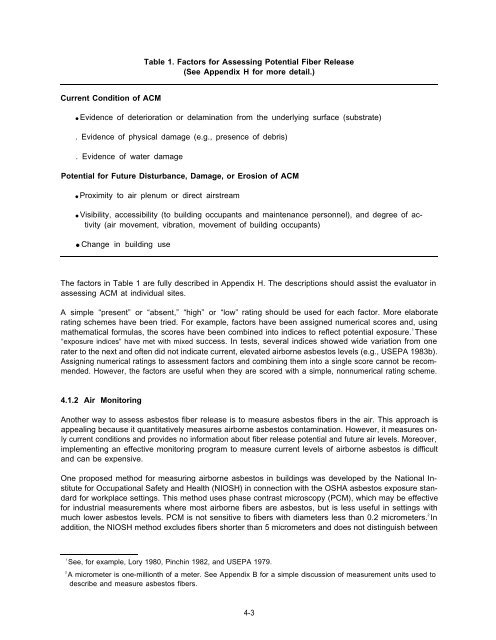EPA 560/5-85-024 Guidance for Controlling Asbestos-Containing ...
EPA 560/5-85-024 Guidance for Controlling Asbestos-Containing ...
EPA 560/5-85-024 Guidance for Controlling Asbestos-Containing ...
You also want an ePaper? Increase the reach of your titles
YUMPU automatically turns print PDFs into web optimized ePapers that Google loves.
Current Condition of ACM<br />
Table 1. Factors <strong>for</strong> Assessing Potential Fiber Release<br />
(See Appendix H <strong>for</strong> more detail.)<br />
● Evidence of deterioration or delamination from the underlying surface (substrate)<br />
. Evidence of physical damage (e.g., presence of debris)<br />
. Evidence of water damage<br />
Potential <strong>for</strong> Future Disturbance, Damage, or Erosion of ACM<br />
● Proximity to air plenum or direct airstream<br />
● Visibility, accessibility (to building occupants and maintenance personnel), and degree of activity<br />
(air movement, vibration, movement of building occupants)<br />
● Change in building use<br />
The factors in Table 1 are fully described in Appendix H. The descriptions should assist the evaluator in<br />
assessing ACM at individual sites.<br />
A simple “present” or “absent,” “high” or “low” rating should be used <strong>for</strong> each factor. More elaborate<br />
rating schemes have been tried. For example, factors have been assigned numerical scores and, using<br />
mathematical <strong>for</strong>mulas, the scores have been combined into indices to reflect potential exposure. 1<br />
These<br />
“exposure indices” have met with mixed success. In tests, several indices showed wide variation from one<br />
rater to the next and often did not indicate current, elevated airborne asbestos levels (e.g., US<strong>EPA</strong> 1983b).<br />
Assigning numerical ratings to assessment factors and combining them into a single score cannot be recommended.<br />
However, the factors are useful when they are scored with a simple, nonnumerical rating scheme.<br />
4.1.2 Air Monitoring<br />
Another way to assess asbestos fiber release is to measure asbestos fibers in the air. This approach is<br />
appealing because it quantitatively measures airborne asbestos contamination. However, it measures only<br />
current conditions and provides no in<strong>for</strong>mation about fiber release potential and future air levels. Moreover,<br />
implementing an effective monitoring program to measure current levels of airborne asbestos is difficult<br />
and can be expensive.<br />
One proposed method <strong>for</strong> measuring airborne asbestos in buildings was developed by the National Institute<br />
<strong>for</strong> Occupational Safety and Health (NIOSH) in connection with the OSHA asbestos exposure standard<br />
<strong>for</strong> workplace settings. This method uses phase contrast microscopy (PCM), which may be effective<br />
<strong>for</strong> industrial measurements where most airborne fibers are asbestos, but is less useful in settings with<br />
much lower asbestos levels. PCM is not sensitive to fibers with diameters less than 0.2 micrometers. 2<br />
In<br />
addition, the NIOSH method excludes fibers shorter than 5 micrometers and does not distinguish between<br />
1<br />
See, <strong>for</strong> example, Lory 1980, Pinchin 1982, and US<strong>EPA</strong> 1979.<br />
2<br />
A micrometer is one-millionth of a meter. See Appendix B <strong>for</strong> a simple discussion of measurement units used to<br />
describe and measure asbestos fibers.<br />
4-3

















